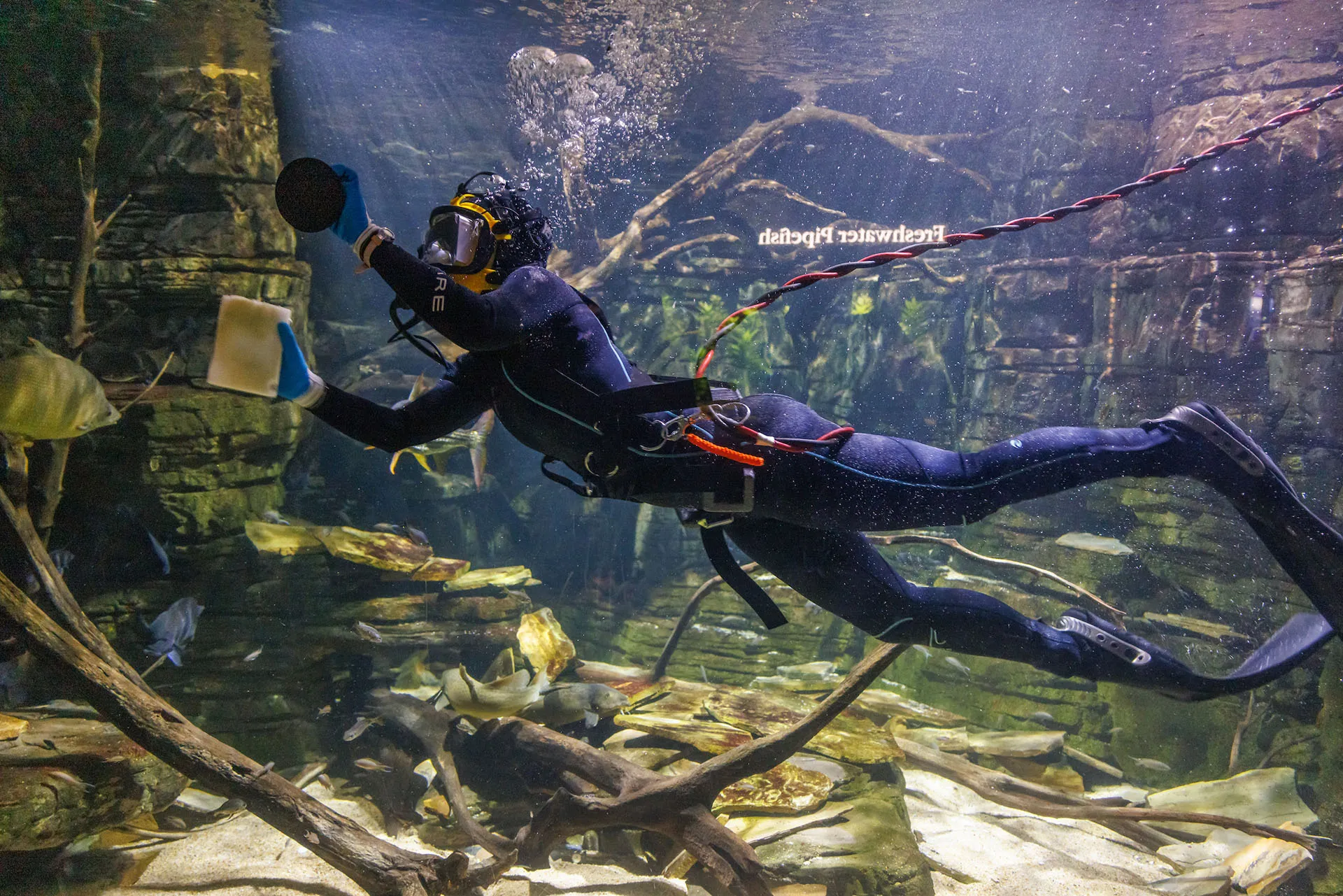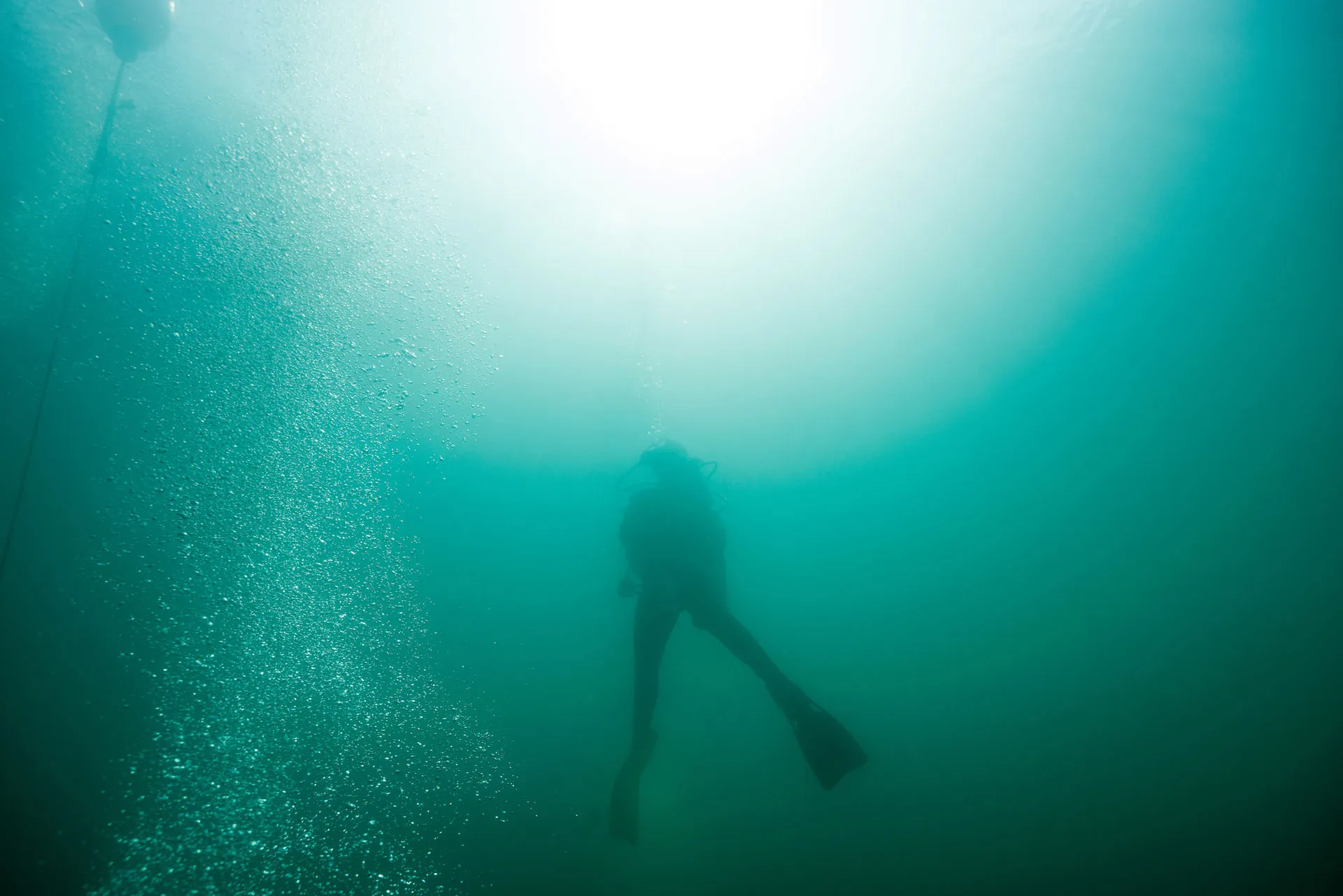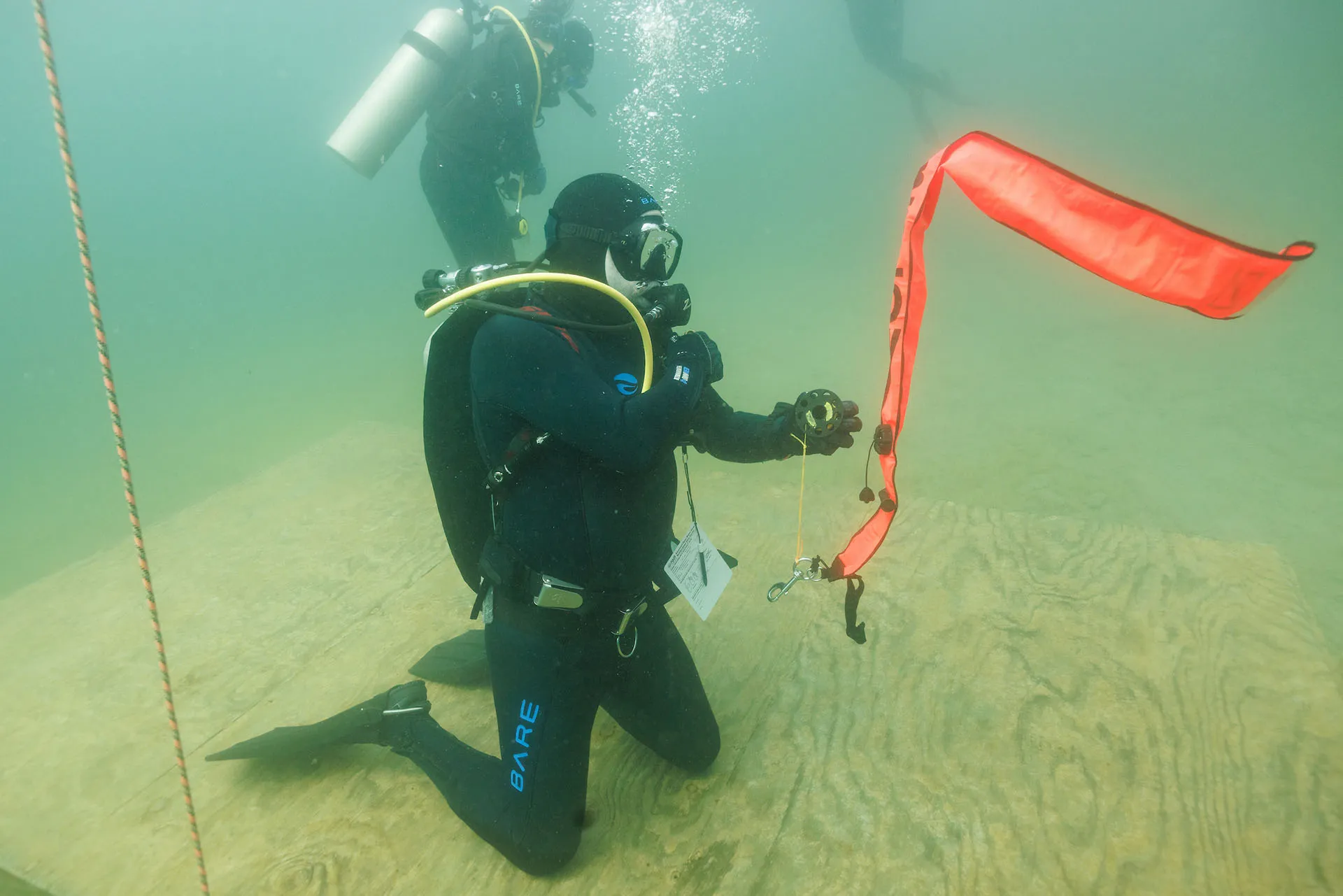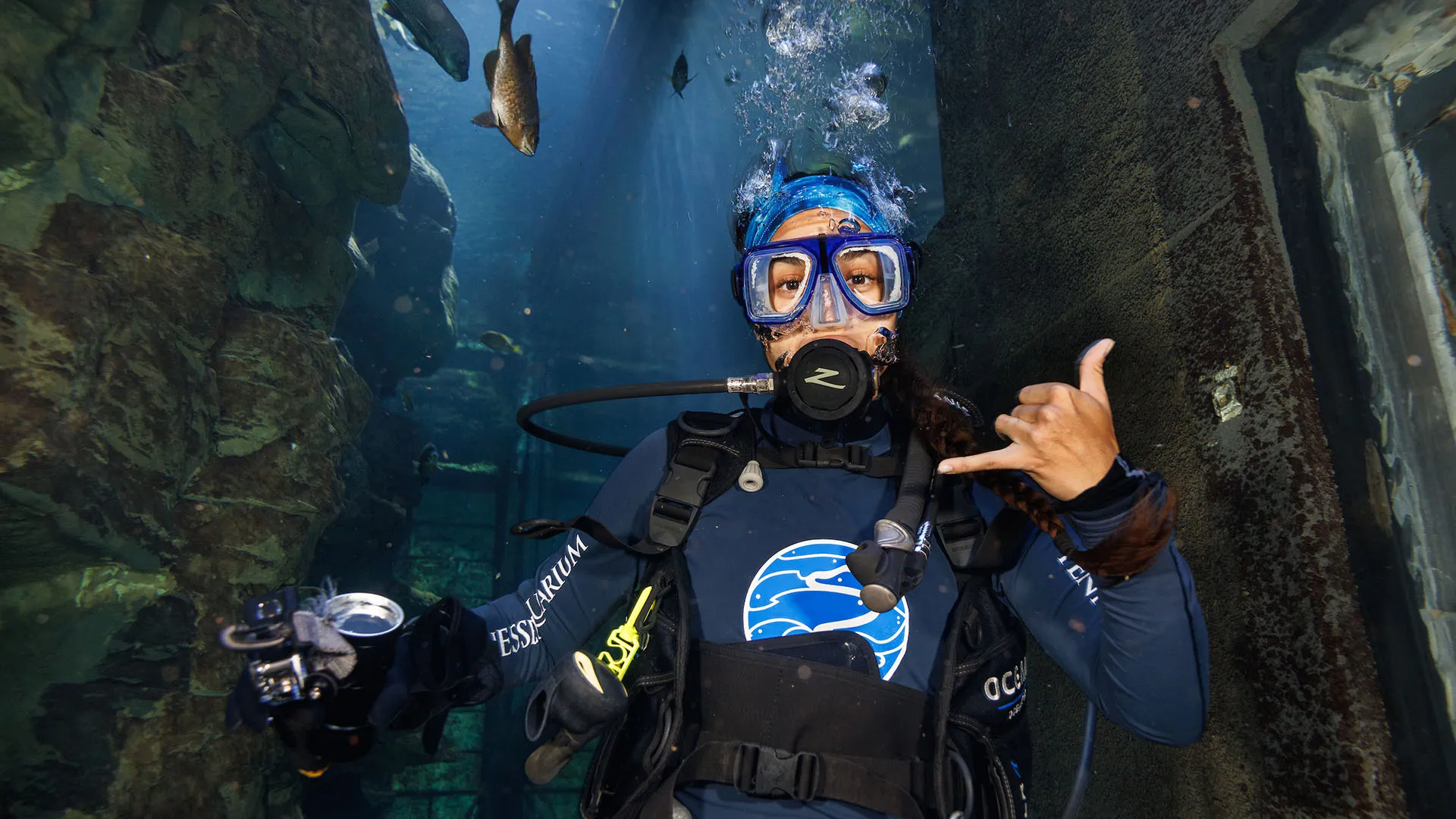With more than 40 aquatic exhibits containing hundreds of thousands of gallons of water between its two buildings, the Tennessee Aquarium has a lot of underwater habitat to maintain. Every exhibit — from a tiny display of Shell-dweller Cichlids to the 618,000-gallon Secret Reef — requires regular maintenance to look its best and provide the healthiest environment for its residents.
 To tackle this mammoth undertaking, the Aquarium enlists the aid of an army of volunteers and staff members who are certified SCUBA divers. These teams take the plunge to mingle with native sunfish in the Tennessee River exhibit, swim among the sharks of the Secret Reef or brave the icy-cold water of the Volga River habitat to see to the animals’ needs and ensure visitors have the best opportunity to appreciate their beauty and grandeur.
To tackle this mammoth undertaking, the Aquarium enlists the aid of an army of volunteers and staff members who are certified SCUBA divers. These teams take the plunge to mingle with native sunfish in the Tennessee River exhibit, swim among the sharks of the Secret Reef or brave the icy-cold water of the Volga River habitat to see to the animals’ needs and ensure visitors have the best opportunity to appreciate their beauty and grandeur.
Aquarium diving isn’t like recreational diving, though.
The skills needed to dive inside exhibits can be more exacting than in open water because of space limitations. While it can be a lot of fun to dive in the Aquarium, for the dive team, it’s also work. They’re underwater to do a job, and it needs to be done efficiently and safely for the sake of the divers, the exhibit and the animals.
“We have some fairly heavily decorated exhibits that are somewhat fragile,” says Manager of Dive Operations and Dive Safety Officer Mark Craven, who oversees the dive program.
“Our acrylic windows are easily scratched,” he continues, “so there is a big push to make sure that everyone is competent with their buoyancy control, with their situational awareness and the ability to work at the same time they’re monitoring all of these things in the water.”
To ensure dive teams can safely operate inside the exhibits, the Aquarium has a rigorous training program for vetting volunteers and a pathway for certifying staff members that can take them from a novice skillset through progressively more-advanced certifications. Every aspect of the program is managed by the Aquarium’s dive officers, who have trained scores of divers since the Aquarium opened in 1992.

A volunteer SCUBA diver scrubs a window in the 618,000-gallon Secret Reef exhibit.

Senior Aquarist Kimberly Hurt scrubs a window in the Lake Tanganyika exhibit in the Aquarium’s Rivers of the World gallery.
The job aquatic
Anyone who has kept a fish tank at home knows even a small, 10-gallon habitat needs regular maintenance. Water needs to be changed, algae needs to be cleaned and substrate needs to be vacuumed to remove fish waste.
“All of those things that you have to do for a home aquarium, we have to do for our exhibits, only on a much grander scale,” Craven says.
For habitats the size of the 137,000-gallon Tennessee River exhibit, it would be impossible to scrub algae from the windows with a pad on a pole. That means divers need to descend into the exhibit to clean the acrylic by hand. They also feed some of the animals by hand, including the Whiptail Stingrays in the River Giants exhibit and the Ripsaw Catfish in the Flooded Amazon.
During their visit, guests are most likely to encounter volunteer divers cleaning, feeding and waving from inside the Aquarium’s three largest exhibits (Secret Reef, River Giants and Tennessee River). However, many Aquarium staff members also dive the exhibits to undertake more specialized tasks.
Aquarists — the team members responsible for caring for fish — are all required to obtain a SCUBA certification and regularly dive within their own exhibits to clean and make any necessary adjustments to the habitat. Many small exhibits are large enough to accommodate divers, even though they may be submerged in just a few feet of water while they work.
Members of the facilities team often obtain a SCUBA certification as well to help maintain exhibit structures and plumbing from the inside. Forestry staff who care for the Delta Country exhibit, which is mostly aquatic, are certified to help maintain these areas. Even the communications and marketing team has divers who capture video footage and photos from inside exhibits.

Diving 101
When a team member needs to dive to perform their job, they are offered a basic open water recreational dive certification administered by the Aquarium’s dive safety officers. This program includes academics to help them understand the implications of physics and human physiology underwater, as well as the use of necessary equipment.
Next, they learn how to safely navigate while underwater through a series of training sessions in a swimming pool followed by several open water dives in flooded quarries near Chattanooga.
That training gives students a basic foundation for diving safely, and the Aquarium’s dive team takes that even further with tutorials tailored to the unique demands of diving commercially in an aquarium environment.
“We build on that basic open water certification with more training in buoyancy control, gas usage and situational awareness,” Craven says. “We teach people how to safely interact with the animals, how to manipulate the basic tools we have to use in the exhibits, and we do a lot of comfort exercises in the water.”
The emphasis on buoyancy control is significant. Much like diving in a reef environment, being able to hold position in the water without rising or falling while breathing can minimize disruptions to sensitive animals or inadvertently damaging exhibits.

Life Support Systems Operator III Liam Creamer, Aquarist II Brenda Salgado, and Assistant Dive Safety Officer Chris Tucker, from left, after a training dive in an area quarry.

Divers watch from a platform about 20 feet below the water’s surface as Tucker demonstrates how to inflate a surface marker buoy.

Creamer practices inflating a surface marker buoy from the underwater platform.
By the time they are diving regularly in the Aquarium’s exhibits, Craven wants divers to be comfortable enough that being underwater is second nature, freeing them to concentrate on the task at hand.
“On your average boat dive, the goal is to jump in the water and have fun, whereas we have much more goal-oriented dives,” he says. “It’s time to do the work.”
The Aquarium’s dive safety officers provide higher-level certifications with advanced techniques for team members whose roles necessitate it. These include advanced open water and rescue diver training. Advanced certifications help keep divers safe in the water.
The Aquarium has never experienced a major dive emergency in its 33 years of operation. If the unexpected were to occur, however, the Aquarium is prepared to handle an underwater incident efficiently and safely, Craven says.
“We train constantly for that possibility,” he says. “Every single person who gets in the water has at least basic first aid, CPR, emergency oxygen administration instruction and then some basic rescue techniques.”
Staff members assigned to oversee each dive and respond to emergencies undergo additional training, and the Aquarium conducts regular drills and training related to dive emergency responses.
Without volunteers, we’d be underwater
 While the staff divers handle the specialized tasks, volunteer divers are the backbone of the Aquarium’s daily dive operations. These teams of three or four divers generously donate their time to helping keep the Aquarium’s three largest exhibits clean and algae-free.
While the staff divers handle the specialized tasks, volunteer divers are the backbone of the Aquarium’s daily dive operations. These teams of three or four divers generously donate their time to helping keep the Aquarium’s three largest exhibits clean and algae-free.
Volunteer dive teams typically conduct three dives every day under the supervision of the dive safety officers. They begin with a morning dive to scrub algae in Secret Reef exhibit before hopping out for a brief break. Next, they re-enter the Secret Reef for an interactive Q&A with guests via a specialized communications system that allows them to converse with educators on the dry side of the acrylic.
Later in the afternoon, the team concludes with a combination scrub and feeding dive in either the Tennessee River exhibit (on odd days of the month) or the River Giants exhibit (on even days).
It isn’t uncommon for volunteers to travel from as far away as Atlanta, Nashville or Birmingham to dive, since the Aquarium presents an opportunity to scratch their SCUBA itch without the demands of traveling hundreds of miles to the Atlantic or Gulf coasts. Interested in becoming a volunteer diver? Learn more here.
